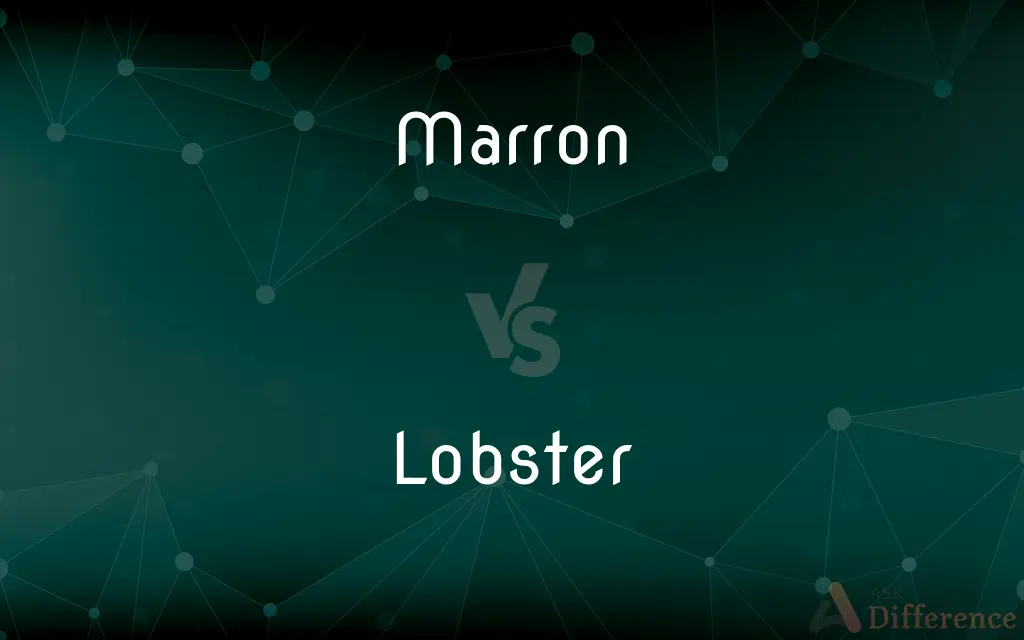Marron vs. Lobster — What's the Difference?
By Fiza Rafique & Maham Liaqat — Updated on March 8, 2024
Marron are freshwater crustaceans known for their sweet, delicate flavor, while lobsters are saltwater crustaceans prized for their rich, succulent meat.

Difference Between Marron and Lobster
Table of Contents
ADVERTISEMENT
Key Differences
Marron, native to Western Australia, thrive in freshwater environments and are distinguished by their two distinct species, including the smooth and hairy varieties. Lobsters, on the other hand, inhabit saltwater habitats worldwide, with several species like the American lobster and the European lobster being highly sought after in culinary circles. This distinction in habitat significantly influences their respective tastes and textures.
The size of marron is generally smaller than that of many lobster species, with marron typically reaching up to about 2 kilograms in weight. Lobsters, especially species like the American lobster, can grow much larger, with some specimens weighing over 4 kilograms. This size difference often reflects in the portion sizes served in culinary dishes.
Marron are appreciated for their sweet, delicate flavor and tender meat, which is often considered a gourmet delicacy in Australian cuisine. Lobsters, with their rich, succulent meat, are celebrated globally, often featured in luxury dining experiences. The flavor profile differences between marron and lobster are partly due to their differing environments (freshwater vs. saltwater).
Culinary preparations for marron and lobster can vary significantly, with marron often grilled, smoked, or served in sophisticated dishes that highlight its delicate flavor. Lobsters are versatile in preparation, famous for dishes like boiled lobster, lobster bisque, and lobster rolls, showcasing their rich taste and texture.
Despite their differences, both marron and lobsters hold a prestigious place in culinary traditions, with their harvesting and preparation being subject to sustainable practices to ensure their populations are preserved. The preference for one over the other is largely a matter of taste and the specific culinary context in which they are used.
ADVERTISEMENT
Comparison Chart
Habitat
Freshwater, primarily in Western Australia
Saltwater, worldwide
Size
Smaller, up to 2 kg
Larger, some species over 4 kg
Flavor
Sweet, delicate
Rich, succulent
Culinary Use
Grilled, smoked, delicate dishes
Boiled, bisque, rolls, versatile preparations
Conservation Status
Subject to sustainable practices, especially in Australia
Globally regulated to prevent overfishing and ensure health
Compare with Definitions
Marron
Gourmet Ingredient.
Marron is often featured in high-end Australian restaurants for its unique taste.
Lobster
Culinary Versatility.
From lobster bisque to lobster rolls, the crustacean's meat is incredibly versatile.
Marron
Delicate Flavor.
The chef prepared the marron with a light sauce to complement its delicate flavor.
Lobster
Saltwater Crustacean.
The cold waters of the Atlantic yield some of the finest lobsters.
Marron
Two Species.
Both smooth and hairy varieties of marron are cherished by culinary experts.
Lobster
Variety of Species.
From the American to the European lobster, each species offers a unique taste.
Marron
Sustainable Harvesting.
Sustainable practices are essential for maintaining the marron population.
Lobster
Luxury Dining.
Lobster is a staple in luxury dining, often served with butter or in rich dishes.
Marron
Freshwater Crustacean.
The marron from the rivers of Western Australia is a prized delicacy.
Lobster
Rich Meat.
Lobster meat is celebrated for its rich, succulent quality, especially the tail.
Marron
A sweet chestnut.
Lobster
Lobsters are a family (Nephropidae, sometimes also Homeridae) of large marine crustaceans. Lobsters have long bodies with muscular tails, and live in crevices or burrows on the sea floor.
Marron
Marron is a name given to two closely related species of crayfish in Western Australia. Formerly considered a single species, it is now recognised as comprising two species, the critically endangered Cherax tenuimanus, and the species that is outcompeting it, C. cainii.Marron are considered a luxury product and are the subject of a developing aquaculture industry in Western Australia and other Australian states.
Lobster
Any of several edible marine decapod crustaceans of the family Nephropidae, especially of the genus Homarus, having stalked eyes, long antennae, a pair of large pincers, and a cylindrical body.
Marron
See sweet chestnut.
Lobster
Any of several similar crustaceans, such as a spiny lobster.
Marron
Cherax tenuimanus, a species of freshwater crayfish from Western Australia.
Lobster
The flesh of a lobster used as food.
Marron
A large chestnut.
Lobster
To catch or try to catch lobsters.
Marron
A chestnut color; maroon.
Lobster
Red-colored, especially from a sunburn.
Red as a lobster
Marron
A paper or pasteboard box or shell, wound about with strong twine, filled with an explosive, and ignited with a fuse, - used to make a noise like a cannon.
Lobster
A crustacean of the Nephropidae family, dark green or blue-black in colour turning bright red when cooked, with a hard shell and claws, which is used as a seafood.
Lobster
A crustacean of the Palinuridae family, pinkish red in colour, with a hard, spiny shell but no claws, which is used as a seafood.
Lobster
A soldier or officer of the imperial British Army (due to their red or scarlet uniform).
Lobster
(slang) An Australian twenty dollar note, due to its reddish-orange colour.
Lobster
To fish for lobsters.
Lobster
Any large macrurous crustacean used as food, esp. those of the genus Homarus; as the American lobster (Homarus Americanus), and the European lobster (Homarus vulgaris). The Norwegian lobster (Nephrops Norvegicus) is similar in form. All these have a pair of large unequal claws. The spiny lobsters of more southern waters, belonging to Palinurus, Panulirus, and allied genera, have no large claws. The fresh-water crayfishes are sometimes called lobsters.
Lobster
As a term of opprobrium or contempt: A gullible, awkward, bungling, or undesirable person.
Lobster
Flesh of a lobster
Lobster
Any of several edible marine crustaceans of the families Homaridae and Nephropsidae and Palinuridae
Common Curiosities
Can you eat both marron and lobster?
Yes, both marron and lobster are highly prized for their delicious meat and are eaten worldwide.
Where do lobsters live?
Lobsters inhabit saltwater environments worldwide, thriving in oceans and seas.
What is marron?
Marron are freshwater crustaceans from Western Australia, known for their sweet, delicate flavor.
What is a popular lobster dish?
Boiled lobster served with melted butter is among the most iconic and popular lobster dishes.
Do marron grow as large as lobsters?
Generally, marron are smaller than many lobster species, with most marron reaching up to 2 kg.
Can lobster be cooked in the same way as marron?
While there are differences in preparation, both can be cooked using a variety of methods depending on the desired dish.
How do you cook marron?
Marron can be grilled, smoked, or incorporated into sophisticated dishes to highlight its delicate flavor.
Which is more expensive, marron or lobster?
Prices vary by location and availability, but both can be considered delicacies and command high prices.
Are marron and lobsters related?
Both are crustaceans, but they belong to different families and environments (freshwater vs. saltwater).
Is marron farming sustainable?
Marron farming in Australia is subject to sustainable practices to ensure the health and longevity of populations.
Are there different species of marron and lobster?
Yes, there are two main species of marron and several species of lobsters, each with unique characteristics.
How are marron and lobster served in restaurants?
Marron are often served in refined dishes to showcase their flavor, while lobster can be found in a wide range of preparations from simple to elaborate.
How do lobsters and marron differ in taste?
Marron have a sweet, delicate taste, whereas lobsters offer a richer, more succulent flavor.
What are the nutritional benefits of eating marron and lobster?
Both are high in protein and omega-3 fatty acids, making them nutritious seafood choices.
What is the conservation status of lobsters?
Lobster populations are globally regulated to prevent overfishing, with efforts to ensure their sustainability.
Share Your Discovery

Previous Comparison
Bass vs. Muskie
Next Comparison
Interval vs. DurationAuthor Spotlight
Written by
Fiza RafiqueFiza Rafique is a skilled content writer at AskDifference.com, where she meticulously refines and enhances written pieces. Drawing from her vast editorial expertise, Fiza ensures clarity, accuracy, and precision in every article. Passionate about language, she continually seeks to elevate the quality of content for readers worldwide.
Co-written by
Maham Liaqat













































